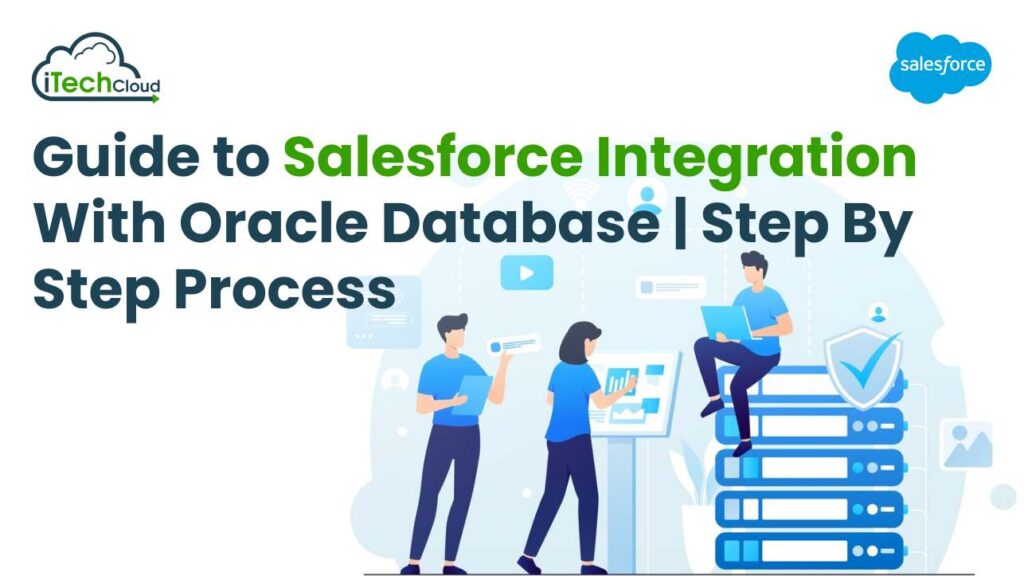Guide to Salesforce Integration With Oracle Database | Step By Step

Introduction:
Seamless integration between Salesforce and Oracle Database is paramount for businesses aiming to leverage the power of cloud-based CRM and robust data management solutions. This detailed guide will walk you through every step of the integration process, empowering you to harness the full potential of these two industry-leading platforms.
Table of Contents
What is Salesforce Integration With Oracle Database?
Salesforce and Oracle Database are two distinct software platforms utilized by businesses for different purposes. Salesforce is a cloud-based customer relationship management (CRM) platform, enabling organizations to manage customer interactions, sales, and marketing activities. On the other hand, Oracle Database is a relational database management system (RDBMS) designed for storing and managing structured data. Integrating Salesforce with Oracle Database allows organizations to synchronize and leverage data between the CRM platform and the database, enabling better decision-making, enhanced data visibility, and streamlined business processes across sales, marketing, and other functional areas.
Step 1: Define Integration Objectives
Begin by clearly defining your integration objectives. Identify the specific data sets that need to be synchronized between Salesforce and Oracle Database, including customer information, sales data, or transaction records. Determine the frequency of data synchronization and any custom business logic or rules governing the integration process.
Step 2: Understand Data Model and Mapping
Gain a deep understanding of the data models of both Salesforce and Oracle Database. Identify corresponding objects, fields, and relationships between the two systems. Create a comprehensive data mapping document that outlines how data will flow between Salesforce and Oracle Database, ensuring accuracy and consistency throughout the integration process.
Step 3: Establish Connectivity
Select the appropriate connectivity option to establish seamless communication between Salesforce and Oracle Database. Salesforce offers a range of integration tools such as Salesforce Connect, Data Loader, or custom API development using SOAP or REST. Oracle Database provides cloud-based integration services like integration with Oracle database Cloud or Oracle Database Cloud Service, enabling secure and reliable connectivity between the two platforms.
Step 4: Configure Data Synchronization
Utilize Salesforce’s integration tools or custom development to configure data synchronization processes. Implement triggers, workflows, or batch processes in Salesforce to automate the synchronization of data integration with Oracle Database. Leverage Oracle Database features such as PL/SQL procedures or triggers to manipulate and synchronize data according to your business requirements.
Step 5: Implement Error Handling and Monitoring
Implement robust error handling mechanisms to address any data synchronization failures or inconsistencies. Set up comprehensive monitoring and logging mechanisms to track the status of integration processes in real-time. Utilize Salesforce and integration with Oracle Database monitoring tools to proactively identify and resolve any issues that may arise during data synchronization.
Step 6: Ensure Data Security and Compliance
Prioritize data security and compliance throughout in the integration with oracle database process. Implement encryption, tokenization, or other data masking techniques to protect sensitive information during transit and storage. Adhere to industry-specific regulations such as GDPR or HIPAA to ensure compliance with data privacy laws and regulations.
Step 7: Test and Iterate
Thoroughly test the integration setup in a dedicated sandbox or development environment before deploying it to production. Conduct functional, performance, and security testing to validate data integrity and system performance. Iterate on the integration with oracle database design based on test results and user feedback to optimize performance and reliability.
Step 8: Document Integration Processes
Document the integration architecture, data flow diagrams, and configuration settings for future reference. Create detailed user manuals and training materials to onboard new users and administrators effectively. Maintain comprehensive documentation to facilitate troubleshooting and scalability as your integration with oracle database needs evolve over time.
Conclusion:
By following this comprehensive step-by-step guide, organizations can successfully integrate Salesforce with Oracle Database, unlocking a wealth of opportunities for enhanced data management, streamlined processes, and improved decision-making capabilities. Embrace the power of seamless integration to propel your business forward in today’s competitive landscape.

